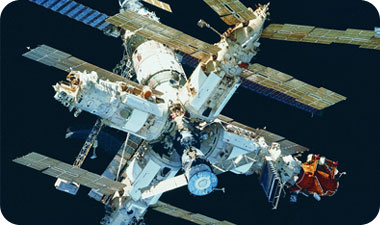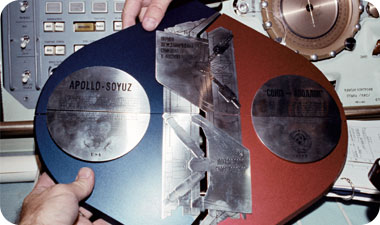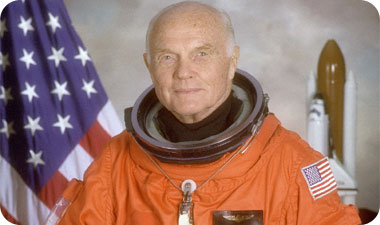On the occasion of the anniversary of the space age, Tal Inbar talks about Sputnik 1, the space race, the intelligence satellites and also about implications for humanity and thoughts about the future. Part one of two
October 4, 1957: The rumble of the engines of the Soviet R-7 launcher carried off into the distance. Sergei Korolev, the chief planner of the Soviet Union's space program, gave the order to activate the rocket's engines, which remained on the launch pad for many seconds, until sufficient thrust was developed, which began to lift the rocket into the air.
A few minutes after taking off from the launch pad known as Baikonur, located in Kazakhstan, the first man-made satellite separated from the last stage of the rocket, and began orbiting the Earth. The space age has begun.
There was Sputnik 1
Fifty years have passed since the launch into space of that small satellite, Sputnik 1. Since then, thousands of satellites have joined it in various orbits around the Earth, manned spacecraft have been launched for various missions, a dozen astronauts have landed on the moon, communication, navigation, intelligence and meteorology satellites have been developed; The world's space industries generate huge sums - over a hundred billion dollars a year; The Earth has truly become a "global village", when satellites enable immediate access to information, and communication between remote areas in the blink of an eye.
Fifty years is a sufficient period of time for a sober observation of the achievements, and an examination of the future directions of space research and space applications for the coming decades. In this issue we trace various events in the first fifty years of the space age, and fifty boxes, scattered throughout the issue, describe the events that took place each year from 1957 until this year, 2007. The canvas is short of containing everything that happened in the jubilee of the past years, and the selection of events was a difficult task - Simple. The choice was made by the writer of these lines, and it constitutes a concise summary of events of special significance to the history of space exploration in the world, as well as to the history of the Israeli space program, which next year will mark 20 years since the launch of its first satellite.
Sputnik effect
The launch of Sputnik 1 was a defining event in human history, and in the history of the Cold War. The technological and scientific importance of the satellite was relatively marginal, but its propaganda importance and psychological impact were great. The very fact that the Soviet Union was able to launch a satellite into space testified to the ability to launch a nuclear warhead to an intercontinental range, from its surface to the United States. This was the military significance of the launch of the first satellite, which placed the United States in a position of great disadvantage. The confrontation between the candidates for the presidency of the United States, Richard Nixon and John Kennedy, revolved, among other things, around the issue of the weak American launchers compared to the huge Soviet launchers. Shortly after the launch of Sputnik, the concept of the "missile gap" was born, a concept coined by the Americans and which came to describe Russian superiority in the number and quality of missiles. Today it is known that this was a myth, which served the United States government well in its request for budgets for research and development programs in the field of launchers, as well as in the field of anti-missile defense.
It is interesting to note that the launch of Sputnik led a group of scientists in the United States to start a science teaching program for youth in the United States, a program known to many readers as "Youth Seeking Science", which has been operating for about forty years in Israel as well, within the various academic institutions. This program was born in the United States out of fear of a large gap compared to the scientific-technological capabilities of the Soviet Union, and a desire to train the next generation of scientists and engineers in the United States.

the space race
The first decade of space flights, and shortly after, was called the "space race" - a technological race and a struggle for international prestige between the two superpowers of the time - the Soviet Union and the United States. It was not science and the advancement of humanity that stood before the eyes of the decision makers in the political establishment of the powers, but a struggle for prestige, influence and political interests. The United States finally won the "big prize", when it landed the manned spacecraft "Apollo 11" on the moon.
The race to the moon ended with a clear American decision, and after the "Apollo" program, the two powers turned to establishing their position in space for other purposes: military, scientific, commercial and technological benefit. It will be many more years before a new competition begins, and this time it will probably be Asian countries - China, India and Japan - who will challenge the absolute supremacy of the United States in the field of space. The destination this time will be the planet Mars, with the moon only being used as a test and testing arena for the technologies that will be required to conquer the red planet.
The intelligence satellites - the keepers of the peace
Many remember the second half of October 1962 as the days when the world stood on the brink of nuclear war between the United States and the Soviet Union, due to the placement of Soviet ballistic missiles on Cuban soil. Few know, even today, that the President of the United States at the time, Kennedy, enjoyed the fruits of the first generation American intelligence satellites, the "Corona" satellites.
Satellites of this series photographed the Soviet Union starting in 1960, and the United States had solid information about the capabilities of the Soviet Union in the field of space, ballistic missiles, fighter planes and more. Since the classification of the intelligence satellites was extremely high, Kennedy could not tell about their capabilities, or even confirm their presence in the hands of the United States. However, their intelligence products allowed him to show toughness against his rival Khrushchev in the fight for the removal of the missiles from Cuba. Kennedy knew that the Soviet Union had a small number of intercontinental ballistic missiles, and that the United States enjoyed a clear superiority in the number of missiles and warheads. The Soviet Union folded and withdrew. The secret of the existence of the American photo satellites was kept for several more years. Decades after the Cuban Missile Crisis, with the start of the operation of the world's first commercial photography satellite with a resolution of one meter ("Ikonos"), satellite photographs entered the public consciousness. It wasn't long before anyone with a computer and an internet connection could view almost every corner of the planet, using the Google Earth software. This software allows anyone access to photographic information from satellites, which until then was no longer the property of powers only. This software has significant implications for national security issues, and many countries have demanded - and their demand has been accepted - to censor certain areas or installations in their possession, for fear of terrorist attacks.

A small world - on the communication satellites
Veteran readers surely remember the Israeli television broadcasts (in black and white...) in which we see a drawing of a satellite dish, and next to it the prominent inscription "via satellite", in the corner of the screen. During the first years of satellite TV transmissions, the technological innovation seemed to many to be a real miracle. The young readers, born into an age of multi-channel television, satellite radio and thousands of television and radio stations that can be received via a home satellite dish, will not understand how world communication was conducted in the era before communication satellites. Today, communication satellites receive a significant part of the budgets flowing to the space industries in the world. Consumers are demanding more and more bandwidth, and satellite manufacturers are encountering increasing technological challenges in their attempt to satisfy the world's hunger for fast and high-quality communication. In the coming years we will see a transition to new areas of broadcasting, increasing the rate of broadcasting and increasing the bandwidth.
Also, it is likely that we will also see refueling services for satellites and other "road services" - which will operate new companies that will guarantee themselves a lot of employment and profits on the side. Communication satellites with high bandwidth and utmost reliability will lead to revolutions in the field of telemedicine - surgeries using robots and computer systems equipped with virtual reality software have already been demonstrated, and will become more and more common over time. One of the challenges of today's space industries is satisfying the "hunger" for bandwidth of mobile consumers - in private cars, public transportation and airplanes.
sorry, where am i? navigation satellites
Many readers of these lines have a satellite navigation system in their car. Even those who do not have a GPS receiver are probably familiar with the American system. Systems of navigation satellites are also in the hands of Russia, China and Europe.
What began as an initiative of the US Navy has become an essential element in the daily lives of many of the inhabitants of the planet: patients waiting for an ambulance, fire brigade teams, civil and military aircraft, land and sea forces, trucks for the distribution of goods and supplies, municipal workers locating a water pipe with an accuracy of centimeters To correct - these are only some of the users of the satellite navigation system.
The world has become so dependent on the satellite navigation systems that shutting them down for various reasons will cause chaos on a global scale, and trillions of dollars in damage to the world's economies. It seems that satellite navigation systems have always been with us; It is so easy to get used to them, that it is hard to imagine the world without them. Our great dependence on these systems emphasizes the need to protect them from terrorist actions (blocking and jamming) and from space weapons systems, during military conflicts.

Space as a battlefield
The space warrior is growing skin and tendons before our eyes. Events of laser dazzle of satellites, explosion of satellites by a dedicated interceptor missile, and designs of combat satellites, have long since left the world of science fiction. We will not be far off today and we will also be familiar with concepts such as "space terrorism" or "September 11 events in space", in which terrorist organizations, sponsored by states or independently, will be able to damage the vital space assets of various countries.
Many efforts are currently being made both in the development of systems for space warfare, and in preventing the retirement and deployment of these systems in space. Heated discussions in academia (mainly in the United States and Europe) deal with the legal and economic issues of space warfare. A summary of the events of the centennial year of the launch of Sputnik 1 will most likely include a summary of the space combat events that will take place in the following decades. If we understand the dangers inherent in space warfare and the disruption of space systems and prepare for them ahead of time, the influence of terrorist elements or "crazy" states will remain quite marginal. If a compromise line is adopted, we can find ourselves damaged in a way that is difficult to describe the full consequences for the quality of our lives and the economy of the entire world.
For the second part of the article: the next 50 years in space
The article was published in Issue 110 of the Galileo journal
